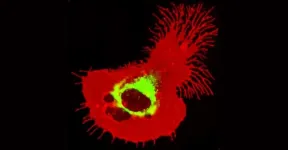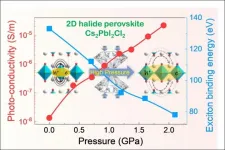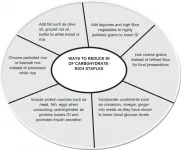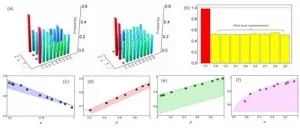(Press-News.org) WEHI researchers have uncovered a process cells use to fight off infection and cancer that could pave the way for precision cancer immunotherapy treatment.
Through gaining a better understanding of how this process works, researchers hope to be able to determine a way of tailoring immunotherapy to better fight cancer.
Led by Dr Dawn Lin and Dr Shalin Naik and published in Nature Cell Biology, the research provides new insight into the way cells adapt to fight infection.
This research lays the foundation for future studies into the body's response to environmental stressors, such as injury, infection or cancer, at a single cell level.
At a glance
WEHI researchers have studied dendritic cells, a crucial component of the immune system, to gain a deeper understanding of how the body produces these cells to fight cancer and infection.
The study found how the Flt3L hormone increased dendritic cells numbers.
Researchers will now apply this knowledge to improving immunotherapy techniques to create more personalised treatments.
Flt3L hormone plays vital role in fighting off infection
Dendritic cells are immune cells that activate 'killer' T cells, which are vital for clearing viral infections, such as COVID-19, but also for triggering a response to cancers such as melanoma and bowel cancer.
The Flt3L hormone can increase dendritic cell numbers, helping the immune system to fight off cancer and infection.
Dr Naik and his team studied developing immune cells at a single cell level to gain a deeper understanding of how the body uses these cells to trigger immune responses.
"There is one type of dendritic cell that the body uses to fight some infections and cancer. The Flt3L hormone increases numbers of this particular dendritic cell," he said.
"We know quite well how the dendritic cell fights the cancer, but we don't know how the Flt3L hormone increases the numbers of those dendritic cells."
Single-cell barcoding provides vital clues to how dendritic cells function
Researchers used a single-cell 'barcoding' technique to uncover what happened when dendritic cells multiplied.
"By using cellular barcoding - where we insert short synthetic DNA sequences, we call barcodes inside cells - we were able to determine which cells produced dendritic cells in pre-clinical models," Dr Naik said.
"As a result of this research, we now better understand the actions of the Flt3L hormone that is currently used in cancer immunotherapy trials, and how it naturally helps the body fight cancer and infection. This is a first step to design better precision immunotherapy treatments for cancer."
Using single cell technology to improve immunotherapy treatment
This research answers a 50-year-long question as to what causes a stem cell to react in response to immense stress, such as infection or inflammation.
"We have known that the Flt3L hormone increases the number of dendritic cells for decades but now there is a focus on applying this knowledge to cancer immunotherapy and potentially to infection immunotherapy as well," Dr Naik said.
"The next stage in our research is to create 'dendritic cell factories' using our new knowledge, to produce millions to billions of these infection fighting cells and then use those in immunotherapy treatments."
"These findings are a vital first step to improving immunotherapy treatments for patients, to help them better fight cancer and infection."
INFORMATION:
This work was made possible with funding from the National Health and Medical Research Council, the Australia Research Council, Gilead, the Victorian Cancer Agency and the Victorian Government.
HPSTAR scientists Dr. Songhao Guo and Dr. Xujie Lü report three orders of magnitude increase in the photoconductivity of Cs2PbI2Cl2 from its initial value, at the industrially achievable level of 2 GPa, using pressure regulation. Impressively, pressure regulating the 2D perovskite's excitonic features gains it 3D compound characteristics without diminishing its own advantages, making it a more promising material for photovoltaic and photodetector applications. Their study is published as a Cover article in the latest issue of the Journal of the American Chemical Society.
Two-dimensional (2D) halide perovskites have recently emerged for photovoltaic and optoelectronic ...
In a report summary released today Thomas McAndrew, a computational scientist and assistant professor at Lehigh University's College of Health includes probabilistic forecasts of the impact of vaccines and variants on the U.S. COVID trajectory over the next few weeks. The goal of the report, says McAndrew, is "to support public health officials, infectious disease modeling groups, and the general public"
Report highlights:
A consensus of 91 forecasters predicts that the B.1.1.7. variant will be found in 42% of all genetic sequences with an S-gene mutation in the first two weeks of March and in 72% in all sequences between ...
Researchers have captured the first detailed images of newborn babies' lungs as they take their first breaths.
The research, led by the Murdoch Children's Research Institute (MCRI) and published the American Journal of Respiratory and Critical Care Medicine, provides a breakthrough in understanding the events around a baby's first breath, why healthy babies cry at birth and provides clues to improving preterm babies' survival chances and long term health outcomes.
About 10 per cent of newborns, and almost all preterm infants, need resuscitation because their lungs do not properly fill with air at birth (a process called lung aeration). Despite ...
New research from UBC finds that higher life satisfaction is associated with better physical, psychological and behavioural health.
The research, published recently in The Milbank Quarterly, found that higher life satisfaction is linked to 21 positive health and well-being outcomes including:
a 26 per cent reduced risk of mortality
a 46 per cent reduced risk of depression
a 25 per cent reduced risk of physical functioning limitations
a 12 per cent reduced risk of chronic pain
a 14 per cent reduced risk of sleep problem onset
an eight per cent higher likelihood of frequent physical activity
better psychological well-being on ...
If you've ever swatted a mosquito away from your face, only to have it return again (and again and again), you know that insects can be remarkably acrobatic and resilient in flight. Those traits help them navigate the aerial world, with all of its wind gusts, obstacles, and general uncertainty. Such traits are also hard to build into flying robots, but MIT Assistant Professor Kevin Yufeng Chen has built a system that approaches insects' agility.
Chen, a member of the Department of Electrical Engineering and Computer Science and the Research Laboratory of Electronics, has developed insect-sized drones with unprecedented dexterity and resilience. The aerial robots ...
Green tea supplements modulate facial development of children with Down syndrome
A new study led by Belgian and Spanish researchers published in Scientific Reports adds evidence about the potential benefits of green tea extracts in Down syndrome. The researchers observed that the intake of green tea extracts can reduce facial dysmorphology in children with Down syndrome when taken during the first three years of life. Additional experimental research in mice confirmed the positive effects at low doses. However, they also found that high doses of the extract can disrupt facial and bone development. More research is needed to fully understand the effects of green tea extracts and therefore they should ...
Imagine a robot.
Perhaps you've just conjured a machine with a rigid, metallic exterior. While robots armored with hard exoskeletons are common, they're not always ideal. Soft-bodied robots, inspired by fish or other squishy creatures, might better adapt to changing environments and work more safely with people.
Roboticists generally have to decide whether to design a hard- or soft-bodied robot for a particular task. But that tradeoff may no longer be necessary.
Working with computer simulations, MIT researchers have developed a concept for a soft-bodied robot that can turn rigid on demand. The approach could enable a new generation of robots that combine the strength and precision of rigid robots with the fluidity and safety of ...
The models used to produce global climate scenarios may overestimate the energy and emission savings from improved energy efficiency, warns new research led by academics at the University of Sussex Business School and the University of Leeds.
In a review of 33 studies, the researchers find that economy wide rebound effects may erode around half of the energy and emission savings from improved energy efficiency.
These rebound effects result from individuals and businesses responding to the benefits of improved energy efficiency - such as cheaper heating, lighting and travel. These responses improve quality-of-life, raise productivity and boost industrial competitiveness, ...
Professor Christiani Jeyakumar Henry, Senior Advisor of Singapore Institute of Food and Biotechnology Innovation (SIFBI), Agency for Science, Technology and Research (A*STAR) and his team have developed a Glycaemic Index (GI) glossary of non-Western foods. The research paper (attached PDF) was published in Nutrition & Diabetes on 6 Jan 2021: https://doi.org/10.1038/s41387-020-00145-w.
Observational studies have shown that the consumption of low glycaemic index (GI) foods is associated with a lower risk of type 2 diabetes mellitus (T2DM), significantly less insulin resistance and a lower prevalence of the metabolic syndrome. ...
Recently, research team led by academician GUO Guangcan from CAS Key Laboratory of Quantum Information of the University of Science and Technology of China (USTC) of CAS, has made an important progress in quantum information theory. Prof. LI Chuanfeng and Prof. XIANG Guoyong from the team, cooperated with Dr. Strelstov from University of Warsaw, investigated the imaginary part of quantum theory as a resource, and several important results have been obtained. Relevant results are now jointly published as Editors' Suggestion in Physical Review Letters and Physical Review A.
Complex number is a mathematical ...







